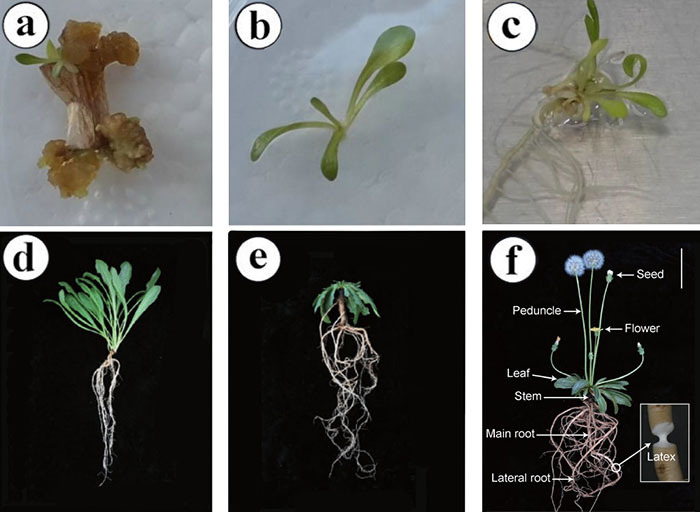Taraxacum kok-saghyz Rodin, often abbreviated as TKS and commonly referred to as Kazakh dandelion, rubber root, or Russian dandelion. It is a perennial plant with a yellow composite flower characteristic of the genus Taraxacum. As the rubber production of rubber trees has been declining year by year and the continued rise in oil prices, people in Southeast Asia where rubber trees were originally planted turned to plant oil palm to produce palm oil and biofuels. Due to the source of natural rubber is increasingly scarce, temperate rubber crops represented by Taraxacum kok-saghyz Rodin have attracted more and more attention. In recent years, research on genetically modified Taraxacum kok-saghyz Rodin has become a hot field to improve the yield and quality of rubber and shorten the cultivation time.

Lifeasible provides one-stop services, covering all steps including experimental design, vector construction, plasmid transformation, positive transplant screening and characterization of transgenic Taraxacum kok-saghyz Rodin. We offer Taraxacum kok-saghyz Rodin transformation using various genetic engineering technologies as follows:
Through the quantitative overexpression of genes related to rubber and other chemical components in Taraxacum kok-saghyz Rodin, the production of specific compounds can be increased. We could help you overexpress many enzymes of the mevalonate (MVA) pathway which might be critical for rubber biosynthesis, and CPT/CPTL gene family & REF/SRPP gene family in TKS.
RNAi refers to the phenomenon of highly conserved, induced by double-stranded RNA (dsRNA), homologous mRNA high-efficiency and specific degradation in the evolutionary process. Through RNAi technology, the silencing of multiple genes in Taraxacum kok-saghyz Rodin can be mediated.
VIGS use viruses carrying target gene fragments to infect plants. After infect of the viruses, the endogenous genes of target plant can be silenced and phenotype of target plant may change, providing information for study of gene function. The VIGS technology is a method of transient transformation and underlying molecular basis may be post-transcriptional gene silencing. Silencing and functional analysis of target genes in Taraxacum kok-saghyz Rodin through VIGS can help you save time and achieve valuable information for gene functional analysis. With wealth of experience in VIGS, the scientists in Lifeasible provides you customized protocol for VIGS in Taraxacum kok-saghyz Rodin. We could achieve the transformation for Taraxacum kok-saghyz Rodin with different genetic backgrounds.
The discovery of the CRISPR/Cas9 system provides us with a very powerful and convenient gene editing tool. By using CRISPR technology, we can achieve knockout of Taraxacum kok-saghyz Rodin genes in different ways, including frameshift mutations, multiple deletion of fragments, knockout of non-coding genes, knockout of multiple copies of genes, etc.
Using the powerful scalability of the CRISPR system, we have developed many methods that can improve gene knock-in efficiency and achieve precise editing of the Taraxacum kok-saghyz Rodin genome. Most of CRISPR gene knock-in is done through HDR. However, NHEJ and HDR will occur at the same time due to DNA breaks. Therefore, we have developed different methods to increase the probability of HDR, thereby improving the efficiency of gene knock-in.
The CRISPR base editing technology was born in 2016. We could help you achieve the conversion from C to T or A to G in Taraxacum kok-saghyz Rodin using CBE and ABE, both of which rely on the DNA positioning capabilities of the CRISPR/Cas9 system. During single base editing, the C base deaminase or A base deaminase is located at a specific position in the genome, and it catalyzes the deamination reaction of C or A at a specific position and turns it into U or I. Then it is treated as T or G in the process of DNA replication, realizing the conversion from C to T or A to G.
The dCas system is an important branch of the CRISPR system. There are many ways to participate in the inhibition of gene expression. For the inhibition of Taraxacum kok-saghyz Rodin genes, we can provide a variety of solutions, including dCas9 binding to targeted DNA and realizing Inhibition of gene transcription through steric hindrance. In addition, gene knockdown can also be achieved by recruiting a fusion protein to the start site of gene transcription.
CRISPRa technology uses the powerful capabilities of Cas9 and sgRNA to fuse or recruit multiple proteins to enhance gene transcription. For Taraxacum kok-saghyz Rodin genes, we provide VPR technology, SAM technology and Suntag technology to allow the CRISPR system to carry more activation element and achieve a stronger activation effect after synergistic amplification.
The study of gene function has always been the core subject of biological research. The earliest genetic screening system established through forward genetics is very inefficient and has a huge workload. However, the reverse genetic screening system based on CRISPR technology can complete very low-cost mutation library construction work. The gene mutation library construction technology we provide for Taraxacum kok-saghyz Rodin including gene knockout library construction, gene knockdown library construction, and gene activation library construction. Moreover, single-cell sequencing is available for mutation screening.
DNA-free gene editing technology has received extensive attention from the industry in recent years. We provide DNA free Taraxacum kok-saghyz Rodin genome editing services, including transient expression of CRISPR/Cas9 plasmid DNA, in vitro transcription of CRISPR/Cas9, and pre-assembled ribonucleic acid composed of purified Cas9 protein and sgRNAs complex. These technologies can avoid the integration of foreign DNA and genome, and reduce off-target effects. In addition, compared with traditional techniques, these techniques can avoid the use of hybridization or backcrossing to isolate CRISPR/Cas9 chimeras, so they are cheaper and have shorter experimental cycles.
So far, the most advanced and widely used method for the development of genetically modified Taraxacum kok-saghyz Rodin is Agrobacterium-mediated. Briefly, the foreign target gene is transferred and integrated into plant cells through Agrobacterium, and then transformed plants are regenerated through techniques such as tissue culture.
 Figure 1. Agrobacterium-mediatedTaraxacum kok-saghyzRodin transformation by infecting wounded shoot apical meristems with Agrobacterium (a) callus with embryos, (b) isolated plantlet, (c) rooted plantlet and (d, e, f) growing whole plant (Lin T, et al. 2018)
Figure 1. Agrobacterium-mediatedTaraxacum kok-saghyzRodin transformation by infecting wounded shoot apical meristems with Agrobacterium (a) callus with embryos, (b) isolated plantlet, (c) rooted plantlet and (d, e, f) growing whole plant (Lin T, et al. 2018)
Lifeasible offers our customers with professional one-stop services, covering all steps including experimental design, vector construction, plasmid transformation, positive transplant screening and testing. Adapting to diverse purposes of different customers, multiple Agrobacterium strains (GV3101, AGL-1, EHA101, EHA105, and C58C1), as well as commercial and customized binary vectors with variant selectable markers (Kanamycin, Hygromycin, Phosphinothricin, G418, etc.) are readily available for your use. Experts at Lifeasible obtain comprehensive knowledge and years of experience to solve technical problems and challenges in Taraxacum kok-saghyz Rodin transformation. We can draw customized solution to help you research on a variety of Taraxacum kok-saghyz Rodin genes (Including CPT/CPTL gene family and other genes that play a key role in the elongation process of rubber polymer, and REF/SRPP gene family and other genes that have a significant impact on rubber expression, etc.), Our services guarantee the success of your project.
Reference: